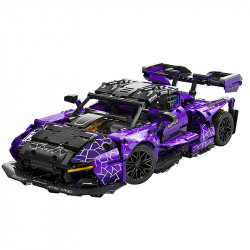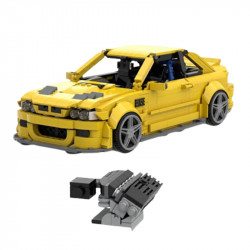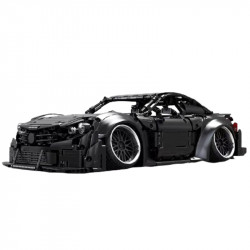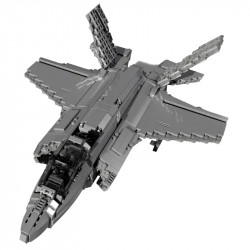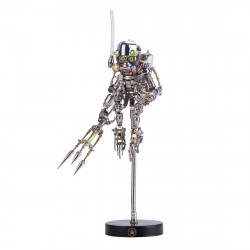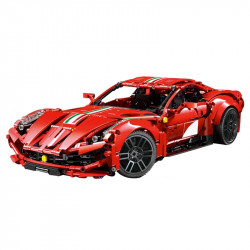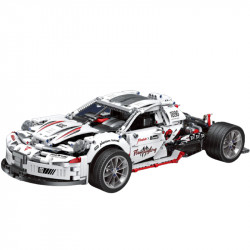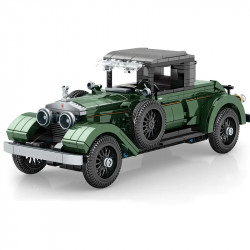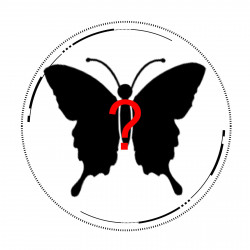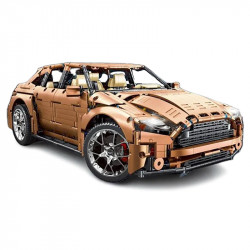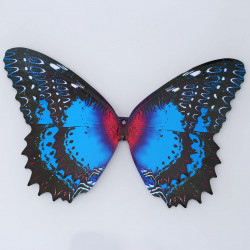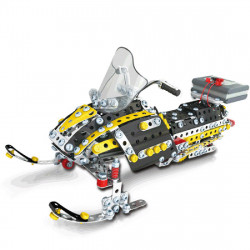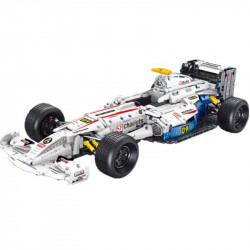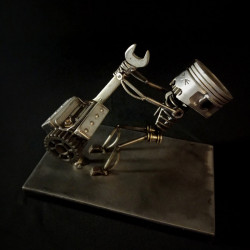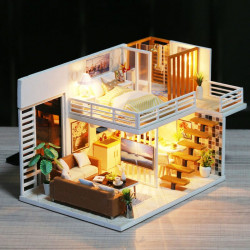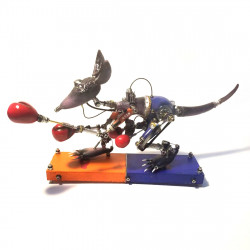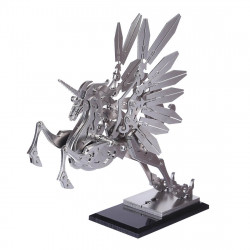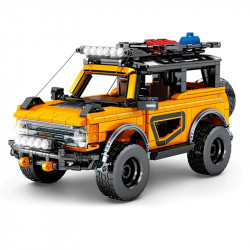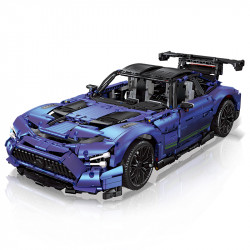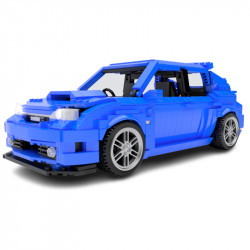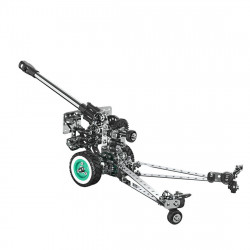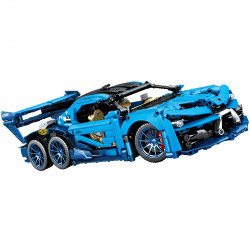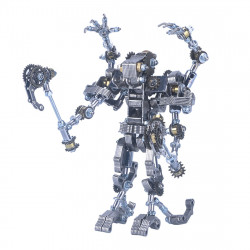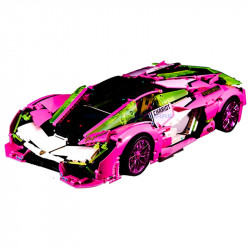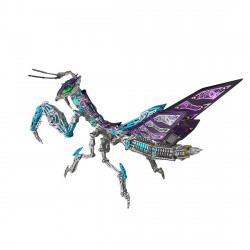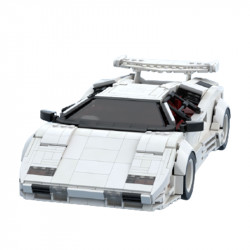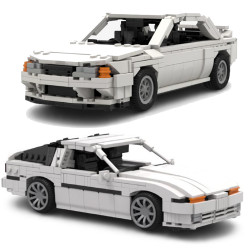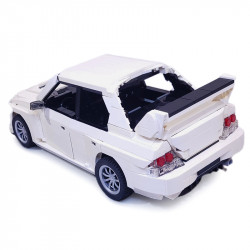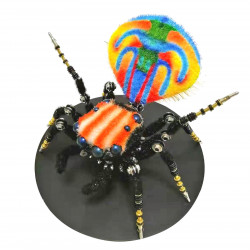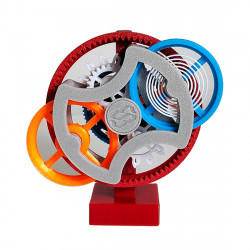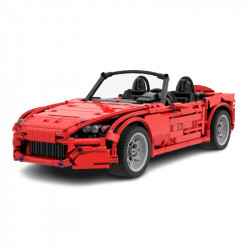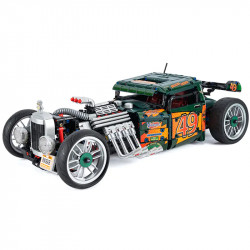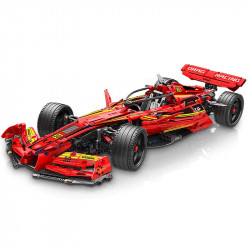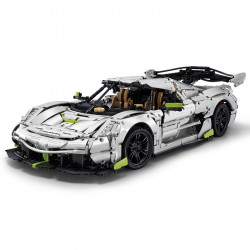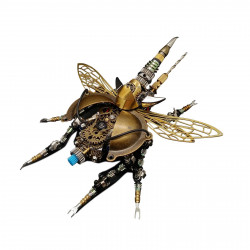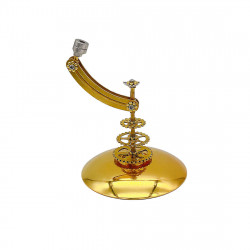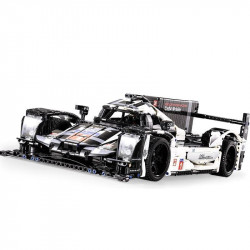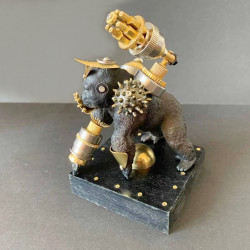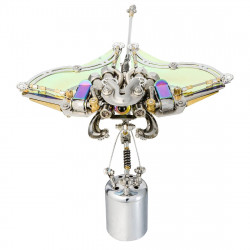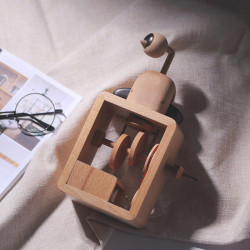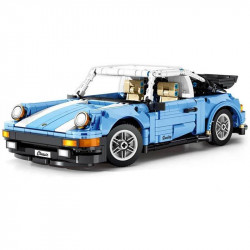Build: Droid Pack Duo

Build: Droid Pack Duo
Yes, I recently completed my 300th construction with an Artoo. As a quick extra follow-up post, I decided to construct the R2-D2 model from the Disney Park special Droid Pack. Since R2-D2 and BB-8 share four pages and a single set of instructions, I should assemble them together.
Although R2-D2 has already encountered color and printed models in the R2-D2 & C-3PO gift set, this is a slightly different experience (and this model also predates the Droid Depot version). In contrast to the silver with color highlights in the gift set, this build has a base coat of white or gray paint with color added where necessary. In addition, the weathering looks fantastic, which sets this construction apart from the Droid Depot build (except from the center leg). Can I say anything else? It's a winner right away because it's Artoo.
However, this model set marks the first time that BB-8 displays his Metal3dpuzzles colors (remember, this pre-dates the Droid Depot models). And despite the weathering, he looks excellent. His body section's different panels are well broken up and distinguished by the hue. He's still not as tidy as you would like, of course, but that's what happens when you try to form a spherical shape out of flat metal bits—unless you manage to do so with a vast number of pieces. Anyway, even though I didn't do that globe as well as I had wanted (though I believe I did a better job than with the silver counterpart, aside from the fact that the silver guy does have my bobblehead modification), this silly little guy is really charming. At some time, I should do a Throwback Thursday on that.
I also brought my bobble-headed BB-8 home and kept my [finally constructed correctly] vintage silver R2-D2 nearby for some comparison photos because comparisons are always fascinating. Ironically, there are some notable size disparities here and in the opposites. While the Droid Pack BB-8 is significantly smaller than its cousin, the Droid Pack Artoo is considerably larger. The way the components fit together into the four shared sheets must have played a role.
As previously stated, I was expecting a brief bonus post with minimal body because, well, Artoo is the same model. I then decided to build BB-8 as well, so I assumed that I would end up examining the BB-8 build procedure. You know what? I was mistaken! A rendering error in the instructions caused some confusion, and I discovered that I had omitted a few things from my R2-D2 build assessment. So, in a single article, here are my two build reviews!
R2-D2
First of all, I totally neglected to mention how I altered the build order for the vintage silver Artoo. Because they changed the order in which you create Artoo to be closer to how I ordered making the original, that came to mind when I was building this one. In essence, the classic silver's instructions ask you to construct a subassembly, attach it, create a lather, rinse, and repeat. In order to avoid being in a sensitive or unbalanced situation while I'm sitting there, I usually build all of the key sub-assemblies and then put them all together at the end.
The silver Artoo required the dome to be assembled first, followed by the body, both side legs, the center leg or bottom cap, the attachment of the center leg or bottom cap to the body, the side legs, the dome, and the base. Does the Droid Pack require you to complete nearly the same steps, with the exception that the bottom cap and center leg are constructed and attached before the side legs? Additionally, you must create both legs before you can attach either. This simplification of the build procedure is really appreciated!
Additionally, I failed to notice a couple of the traditional silver model's challenge points, which were in the foot formation. They instruct you to fold down the side flaps before folding up the "slotted" top, as I previously stated in the Droid Depot review. Physically, that is not conceivable. Don't try it, then. Additionally, the clearance was not correctly estimated, and the side flaps will not fold over flat even if you fold the slotted top first (at least on the side feet). All you need to do is manhandle them into position.
Additionally, the small, rounded, box-like objects on the inside of the side legs can be a real annoyance. I don't have much guidance on that front; I form them carefully and patiently. Oh, and in case it wasn't obvious, this also holds for the Droid Pack model.
Regarding recommendations unique to this design, pay close attention to the directions for mounting components 21 and 29. I've contacted Fascinations to inform them of the rendering error I discovered in the instructions that came with my package. It is hoped that they will make an updated version of the instructions available online and update any subsequent prints. In any case, you should be aware that on this sub-assembly, the side of these pieces that has the etched line faces "out." This indicates that the side shown in the instructions is the one that is not engraved. To put it another way, follow the schematics' tilt of the rectangle cutout rather than the tab locations.
I chose which side faced out based on the tab placements, which are incorrect in the depiction for each of these phases. It wasn't until the very end that I realized the tabs didn't fit into their slots when I was trying to attach the side legs to the body. Nevertheless, if you do make the same error, you should be relieved to learn that it is easy to correct (at least assuming you folded the tabs that hold these components to the leg assembly). Please remove them and replace the left leg with the right. Since these sections are mirrored image sections, the tabs are folded appropriately for the use of the mirror image if you fold them "backward." Cheers!
I was unable to increase my build time because of the leg confusion, and I once again clocked in at about two hours and fifteen minutes. I didn't anticipate the uncertainty, but I assumed that the build's familiarity would speed things up.
BB-8
Beebee-Ate, ahhhh. I adore BB-8. I also despise BB-8. The model, not the persona. Furthermore, it's not an awful model, so I don't particularly despise it. I adore the model and love building it.
Simply put, I detest the model because I'm a perfectionist. Making an exact sphere out of a flat sheet of metal is not a viable or suitable method. And that's where this model gives me trouble. I'm never entirely up to par, even though I want to make everything appear as excellent as possible. I detest my incapacity to give BB-8 the proper execution that he merits because he's so charming.
If you haven't already, the largest issue in developing this model is making it spherical. Accessing all of the tabs inside is an additional task, and it becomes increasingly difficult as you block off all but two of the interior entry points. So, how do you handle these difficulties? Patience and perseverance!
You get to create some bizarre-looking bits that resemble semi-spheres right away. Even though the two sections appear to be the same, there is one crucial distinction: where the two "fold-out" tabs are located in each section. They are situated in the upper quadrant of the first one and the lower quadrant of the second. Regardless, these components cannot be shaped into actual spherical shapes. Trying to bend the huge sections between each set of "holes" over a C-battery was how I went about mine. I used the half-cut fold lines on the inside of the model as a guide for my shaping as I worked it into a spherical shape through extensive hand forming. After that, I merged the two parts and worked on the curves by hand a lot more.
The first four circular panels are then attached to the holes around the "equator" of the BB-8's body using a method that is not precisely lather rinse, repeat. This is difficult in a number of ways. The round panels must first be shaped into a dish-like shape while maintaining a smooth curvature. In order to "level" it, I like to form it closely by hand, then secure the tabs, shape it some more, and then press flat against a surface (slightly flattening the tabs, but that's acceptable). It can be not easy to attach these panels to the body after that. Fortunately, they extended the tabs, making it more straightforward to line them. However, because each panel fits extremely snugly, I was unable to get them all situated.
Because you have to reach inside the model to secure the tabs, this is also where you start to have fun with access concerns. I enjoy grasping the tip of a tab with my fine-tip needle-nose pliers, then carefully "rolling" the pliers to the side while pushing the tab through as much as I can. I then twist or flatten the tab. However, you will have fewer and fewer access locations as you progress. There is less illumination as well. I was fortunate to have recently acquired a ridiculous selfie light ring that I could position on my arm, allowing me to gaze through the center of the ring and brighten the interior.
I must now make an admission. I made a complete mess of installing these four panels. I can't recall how, but I messed up the body, and it rolled across my table after I had attached the first two panels. After picking it back up, I attached the following two panels. But you know what? These panels are all different. And it's not precisely leather-rinse-repeat because they have different orientations between each one.
Additionally, I picked up the ball incorrectly after dropping it, which resulted in two panels being inverted and out of order! I thought about leaving it that way. But I was aware that it would annoy me. In order to reattach the two panels in the proper location and orientation, I had to go through and remove them again, even untwisting the tabs. I had to fervently pray that I wouldn't break a tab, which made it nerve-racking. Fortunately, I was successful because I was patient and slow. Don't be like me, though. Don't make a mistake.
The top and bottom panels are the following two panels you have remaining. They did both for symmetry, but these attach differently because they must, or at least one does. They place the tabs on the body and have them emerge through the slots in the panels rather than entering. It's a great solution, but it isn't easy to implement. The tabs all appeared to be too far apart, and aligning them was hard because I don't think I curled my body portions sufficiently beforehand. However, attempting to fold tabs over while you are unable to support the sections to which the tabs are attached is the most absurd step. The roll-to-tighten method works well in this situation as well. With that, you've completed the body at last!
At this stage, forming the head and base is actually quite simple. You are undoubtedly relieved at this point that a simple dome-shaped curve is all that is required. I was joking. In any case, the head does include some sensitive parts, and I recommend attaching them in a slightly different order: short antenna (48), long antenna (47), and eyes/cameras (49/50, 51). I suggest this because you want to do those small antennas last. After all, they are very easy to manipulate. Additionally, attaching the large antenna first causes obstructions when attempting to attach the short one.
